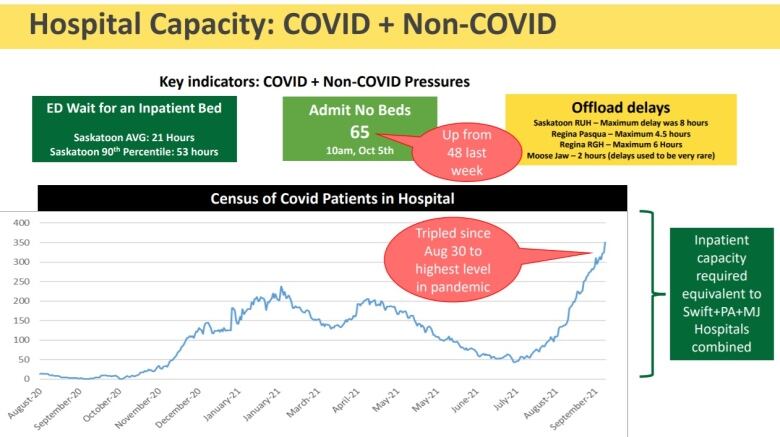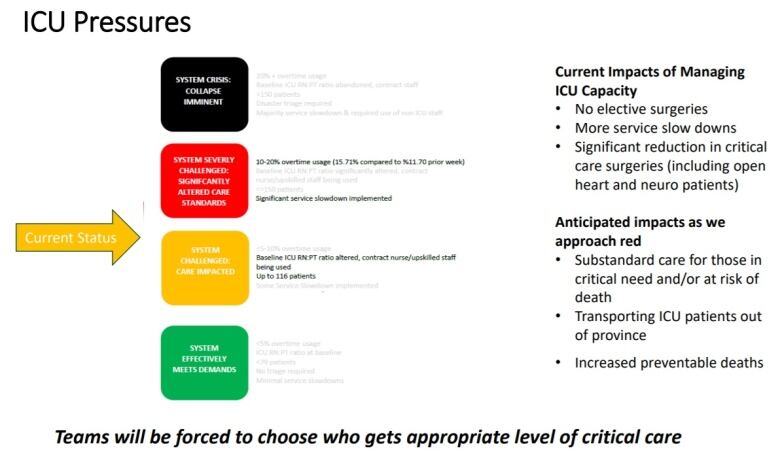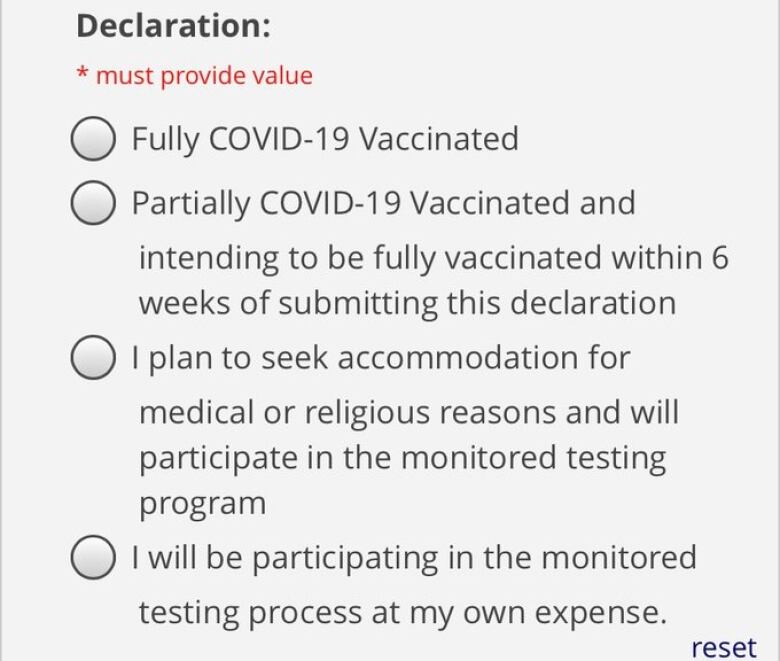Not all Sask. COVID-19 deaths happening in hospitals, plus other takeaways from the latest SHA doctors meetup
Average wait time for an inpatient bed in Saskatoon has recently averaged 21 hours

Some of the people dying with COVID-19 in Saskatchewan are doing so outside of hospitals and other clinical settings, according to a doctor with the Saskatchewan Health Authority.
The SHA hosted its latest COVID-19 physician town hall lastThursday. The forum, which happens every two weeks,allows doctors to share information and advice among themselves but alsocontains a wealth of up-to-date information on Saskatchewan's COVID-19 epidemiology and, increasingly, the severe strainthe health-care sector is in from a flood of mostly unvaccinated COVID-19 patients.Presentations made during thetown halls are then typically posted onlinethe following day.
As of Tuesday, atotal of 753 Saskatchewan residents with COVID-19 haddied since the beginning of the pandemic. Of those deaths, 180occurred since July 11, 2021, when the province dropped all of the public measures intended to curb the spread of the disease. Some of those measures have since been reinstated.
"In the last 14 days, we have ranked consistently as the highest rate of COVID deaths amongthe provinces in Canada," said Dr.Johnmark Opondo, an SHA medical health officer, during Thursday's town hall.
"We're looking at trying to unpack this a little bit more, and it is significant because not all these mortalities are happening in our facilities," Opondo said. "We are seeing significant mortality, not just in the hospital, in critical care, but in community as well. Definitely our hearts go out to thefamilies who experienced this."

Opondo did not specify where else deaths are taking place. CBC News has reached out to the Ministry of Health for more information.
Opondo and other doctors provided updates at the forum on several fronts, including increased wait times for people needing intensive care, positive and negative trends in the province's continuing vaccination efforts, and a looming deadline for health-care workers.
Here are some key takeaways, along with some town hall slides that help illustrate the situation.
WATCH| Dr. Susan Shaw provides update onwhat's happening in Saskatchewan's hospitals due to COVID-19:
Challengingto staffICU beds
As of Thursday, the SHA was on the cusp of exceeding a total of 116 intensive care (ICU) patients, including both COVID and non-COVID patients.
Hospitals had a total of 79COVID patients in ICUs, which was equal to theoverall number of ICU beds the health authority normally has readythroughout the province, said John Froh, a deputy chief medical officer at the SHA.
"One hundred percent of our baseline ICU capacity has been consumed by a single disease process that is preventable with vaccination," Froh said.
While the health authority is workingto "surge" its ICU bed capacity, "we are under significant or extreme HR pressure" to staff those beds, Froh said.
Waiting to get off a stretcher
On the patient side, the fourth wave is causing some wait times to increase, said John Ash, the SHA'sexecutive director of acute care in Regina.
All elective surgeries are already cancelled, and as patient volumes increase, nurse-to-patient ratios will be stretched and "more and more surgeries" will need to be cancelled, Ash said.
The average wait time for an inpatient bed in Saskatoon has recently averaged 21 hours, Ash said.
"These are patients that have been admitted through the emergency department that are waiting in the emergency department for a bed, which is obviously not ideal," he said.

Paramedics have also not been able to get patients immediately off stretchers once they arrivedat an emergency room.
At the emergency room at Royal University Hospital in Saskatoon, the maximum delay was eight hours, while PasquaHospital in Regina experienced a wait time of 4.5 hours and Moose Jaw Hospital patients faced a wait of two hours.
"EMS delays in Moose Jaw are almost unheard of," Ash said. "Our inpatient capacity is equivalent to utilizing all of Swift Current, Prince Albert and Moose Jaw and filling them up with COVID patients."
Patients on oxygen outside ICUs
During the third wave last spring, most days saw fewer than 30 people requiring high-flow oxygen unable to get a bed in an intensive care unit.
During the fourth wave, that number has hovered around or exceeded 40.
"It's a really strong reflection ofhow sick patients are and the burden of care that is being placed on our inpatient units outside of ICU," Ash said.

When the total number of occupied ICU beds (including COVID and non-COVID patients) exceeds 116 which couldbe soon the health system will move to the next, red-colouredtier of its ICU capacity model, which could see patients moved out of province, Ash said.
"That obviously increases the probability of preventable deaths across our system," hesaid.

Younger unvaccinated no longer have excuse: doctor
Recent weeks have seen an encouraging increasein the number of people getting their first dose of COVID-19 vaccine, officials say.
Overall, across all age groups,Saskatchewan has seen a three-per-cent increase in first doses administered daily over the last two weeks, saidDr. Tania Diener, the SHA'sCOVID-19 immunization co-chief.
"If you think back about four to six weeks ago, you would not have seen percentages like this in terms of change over a two week period of time. It was usually about one per cent or so," Diener said.

Saskatchewan announced its proof-of-vaccination program on Sept. 16 and the system took effect on Oct. 1.
"Most days the number of first doses administered are actually more than the number of second doses," Diener said of recent weeks.
People aged 12 to 39 are still lagging in vaccinations, though.
"I think the excuse of 'they were the last to join the pack to get immunized' we passed that phase," Diener said."They've had long enough now, so it is quite concerning that the population is still so low in terms of coverage. It differs across the SHA, with some areas significantly higher for that age group than others."
Most SHA workers indicate they're already fully vaccinated
The SHA announced on Oct. 1 that its employees, doctors and contract workers would need to provide proof of vaccination or else submit to regular testing for COVID-19. The Saskatchewan government had previously announced similar requirements for its workers.
Dr. Susan Shaw, the SHA's chief medical officer, said that as of last Thursday, more than 20,000 health authority workers had already taken the first step of declaring whether they were fully vaccinated, partially vaccinated orplanning to submit to regular testing at their own expense.
"The vast majority are indicating that their intent is to share with us that they are fully vaccinated," Shaw said.

Workers have until Friday to fill out the initial declaration and then until early November to provide their proof of vaccination.
"Safety is important enough that if you're not able to be vaccinated or [give] proof of a negative test, it's not safe for you to be at work," Shaw said.
One in five health-care workers werenot vaccinated when the program was announced, according to the SHA.













_(720p).jpg)


 OFFICIAL HD MUSIC VIDEO.jpg)
.jpg)



























































































